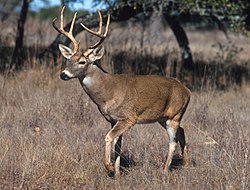Top Qs
Timeline
Chat
Perspective
Odocoileus
Genus of medium-sized deer From Wikipedia, the free encyclopedia
Remove ads
Odocoileus is a genus of medium-sized deer (family Cervidae) containing three species native to the Americas.[1][3][4] The name, sometimes spelled odocoeleus, is a contraction of the Greek root odont-[5][6], meaning "tooth," and -coelus, New Latin for "hollow".
Remove ads
Extant species
 | Odocoileus hemionus | Mule deer | western half of North America. |
 |
Odocoileus pandora | Yucatan brown brocket | Yucatán Peninsula (Mexico, Guatemala, Belize) |
 | Odocoileus virginianus | White-tailed deer | throughout most of the continental United States, southern Canada, Mexico, Central America, and northern portions of South America as far south as Peru and Bolivia.[7] |
History
The genus Odocoileus was named by French zoologist, Constantine S. Rafinesque, in 1832, based on teeth and part of a jaw (presumably of Odocoileus virginianus) gathered by a Mr. Wardel from an anonymous cave in Carlisle, Pennsylvania on the banks of the Conococheague Creek, and kept in the collection of a Mr. Hayden of Baltimore. Rafinesque could refer these teeth to no other living animal known to him, despite having then lived in native white-tailed deer habitat for decades (although the white-tailed deer had been previously described in the literature, between 1850 and 1900 the white-tailed deer population was reduced to 300,000 to 500,000 individuals, found only in remote locations inaccessible to humans[8]). Rafinesque described enamel that covered the tooth, including the hollow inside, and named the species Odocoileus speleus, for "teeth well hollowed" and speleus referring to a cave.[9][10][11]
Remove ads
References
Wikiwand - on
Seamless Wikipedia browsing. On steroids.
Remove ads

